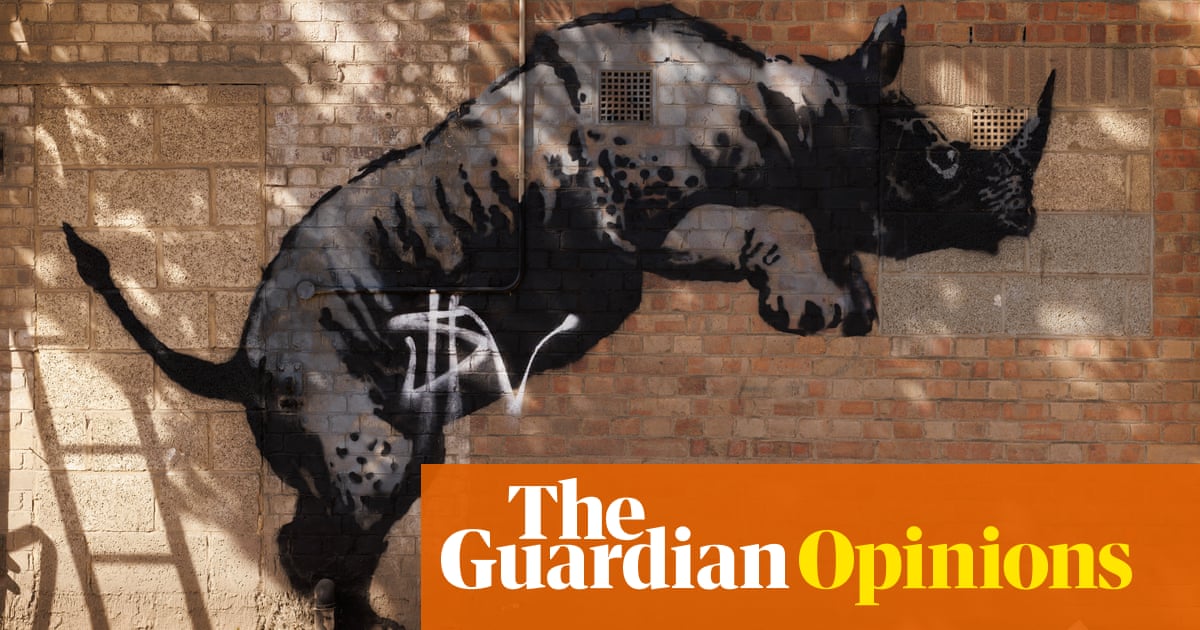This month, stencilled artworks by the street artist Banksy have been defaced, as with his Nissan-trampling rhino, or removed, as with his satellite-dish wolf and hoarding-bound big cat – sometimes just hours after their first public appearances.
While the wolf was either stolen to order or opportunistically taken (and, much like the bronze Barbara Hepworth that was stolen and probably sold for scrap, is now worth many times less than its market value as a result of being formally unsellable), the thievery is not hugely dissimilar to the public removal of Banksy works by the official owners of the sites his pieces appear on. Often cut out of their walls to be sold at auction, you could argue they have been stolen from the public, to whom and where they rightfully belong.
But the erasure of Banksy’s work, in particular because of the art form he uses, is complicated. If you live in an area where there’s graffiti, you’ve probably noticed how it often goes through “cross-out wars”, with one artist superimposing their work over another’s, leaving just enough of the original so it remains clear whom they have supplanted. Banksy’s works have certainly been subjected to this before – as shown by his spat with the sadly now deceased King Robbo.
It’s worth saying that I don’t think the recent removals are mere graffiti beef: they bear the markers of a more opportunistic defacement, having been done in broad daylight and not using a traditional graffiti format. But as an anthropologist who has studied graffiti ethnographically for more than 20 years, I still find the saga riveting.
Graffiti is supposed to naturally decay and die, not be preserved like a work in a gallery. The conservation of these public works by private organisations, as seen in the Banksy pieces trapped behind protective plexiglass, therefore goes against one of the most basic characteristics of graffiti: its being an artefact that should never try to defeat the natural cycle of life and death.
Banksy’s works don’t function within the regulations of the museum, in which conservation and the freezing of time is key. Their destruction could in many ways be seen as an act of preserving the ideals of graffiti practice itself.
Even more importantly for graffiti writers, public works are public, and should never be bought and sold. Yet the purposeful destruction of other Banksy works by graffiti writers has not been done, as many people have suggested to me, as a mere critique of Banksy’s commercial success.
Banksy’s public works do not reap him any direct financial reward, being sold within the secondary market with no artistic royalties due. It is, instead, the use of the street as a site of economic gain that is the issue for many graffiti writers. Destroying the works prevents them from being monetised.
What would Banksy think of all this? In the world of graffiti, destruction is an accepted and expected part of the game: as soon as a work is completed, the countdown to its eventual erasure begins. Impermanence is fundamental, and as long as the image has been documented (in people’s memory or photographs) the work isregarded as complete. As Banksy comes from a background within the graffiti subculture himself, I’m pretty sure he feels broadly sanguine.
Yet let’s be clear. While the destruction of Banksy works is almost always universally condemned by art lovers and institutional bodies, local councils and heritage organisations today remove graffiti at an irrepressible pace, without anyone making a sound.
The erasure of graffiti is the default mode: in the past, other works by Banksy have been lost in this way, sometimes to the horror of those who have removed them. What is considered art (and therefore appropriate for saving) and what is seen as vandalism (and therefore earmarked for destruction) is a question often tied to financial, rather than aesthetic, value.
With cities around the world increasingly suffocated by advertising, however, why is it that only images with financial value – be they art or adverts – are considered an acceptable part of how our cities look? Graffiti writers are still being imprisoned in the UK for placing pigment on a surface (and almost always a public rather than a private surface), while street artists like Banksy get away with the same acts owing to parochial decisions about what constitutes art. So why, even if we don’t like it, is the right to the city given only to those who can pay for it, or for things people think are worth paying for?
Banksy might well be unbothered – or at least unsurprised – by the destruction of his artwork, seeing as that’s one of the risks inherent to the graffiti game. As for the rest of us, shouldn’t we be more concerned when other artists have their works removed, or are imprisoned for making art? And who, more to the point, is causing the real vandalism of our cities today?
If it comes down to a choice between graffiti writers and corporate advertisers, I know where my aesthetic choices reside.
-
Rafael Schacter is an anthropologist and curator working on public and global art. His fourth book, Monumental Graffiti, will be published in October
